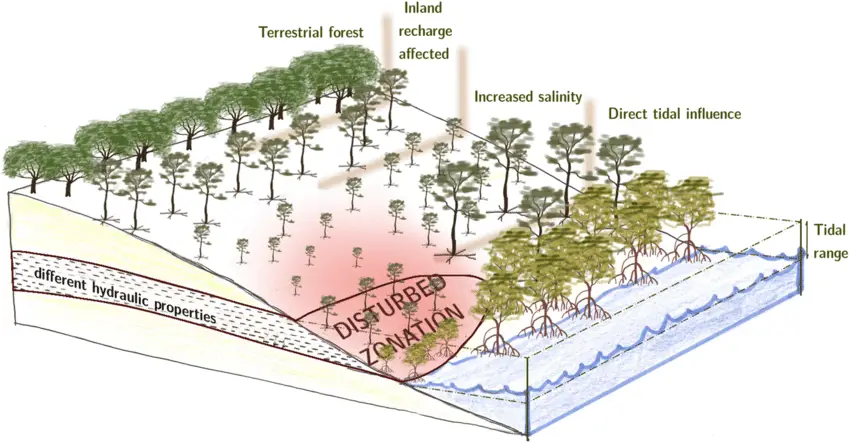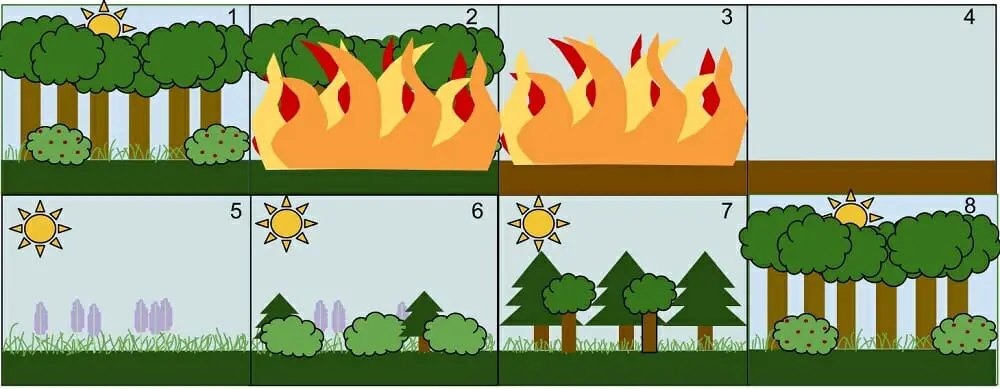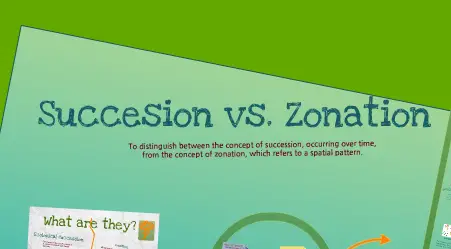Ecological processes are foundational to understanding how environments function and change over time. Zonation and succession are two such processes that dictate the spatial distribution and temporal dynamics of ecosystems. Although they share a common ecological significance, their roles and outcomes differ fundamentally.
Zonation refers to the spatial arrangement of ecosystems, usually in response to a gradient in environmental conditions. For instance, in a marine environment, zones range from intertidal areas exposed to air, to deeper waters. On the other hand, succession describes the sequential development of a community over time, such as the gradual recolonization and maturation of a forest after a fire.
Both zonation and succession are crucial for maintaining ecological balance and supporting biodiversity. They influence everything from the types of species found in a region to the overall structure and future trajectory of habitats. Understanding these processes is key to effective environmental management and conservation strategies.

Zonation Explained
Definition of Zonation
In ecology, zonation is the distribution of plants, animals, and ecosystems into distinct zones, each characterized by a specific set of environmental conditions. This spatial separation reflects how different species and communities adapt to varying degrees of factors such as light, moisture, temperature, and soil type.
Key Characteristics
The key characteristics of zonation include:
- Distinct boundaries: The transition between zones is often clear and observable, where one set of species replaces another.
- Gradient response: Zones typically form along a gradient of environmental changes.
- Predictability: The distribution of zones follows predictable patterns that are determined by environmental gradients.
Factors Influencing Zonation
Several factors can influence zonation, including:
- Topography: The shape and features of the land can affect sunlight exposure, moisture levels, and wind patterns.
- Climate: Temperature and precipitation significantly determine the types of zones that can develop in an area.
- Soil conditions: Soil type, pH, and nutrient content influence the growth of specific plant species, which in turn supports various animal communities.
- Light availability: Particularly in aquatic environments, light penetration can define zonation patterns.
Types of Zonation
Horizontal Zonation
Horizontal zonation refers to the arrangement of ecosystems across a landscape, commonly observed on a large scale from coastal areas inward or across plains.
Vertical Zonation
Vertical zonation occurs with changes in elevation, such as on mountainsides, where temperature and air pressure lead to different life zones at various heights.
Zonation Examples
Marine Zonation
Marine environments showcase clear zonation patterns, especially in intertidal zones where organisms are distributed based on their tolerance to exposure to air and their ability to retain moisture during low tides. For example:
- High intertidal zone: Occupied by organisms that can survive long periods exposed to air.
- Mid intertidal zone: Home to species that tolerate moderate exposure.
- Low intertidal zone: Consists of species that are mostly submerged.
Forest Zonation
In forests, zonation is evident through variations in tree species and undergrowth as influenced by altitude or soil moisture. Alpine forests, for example, demonstrate a shift from deciduous trees at lower elevations to conifers as altitude increases.
Succession Overview
Definition of Succession
Succession is an ecological process involving the gradual sequence of community changes in an ecosystem, leading to ecological stability over time. It begins after a disturbance and progresses through stages until reaching a climax community.
Primary vs. Secondary Succession
- Primary succession: Starts on barren landscapes where no soil exists, such as on new volcanic lava or a retreated glacier. Pioneer species like lichens and mosses are the first to colonize.
- Secondary succession: Occurs in areas where a community has been cleared by disturbances (like fire or farming) but where soil remains. It generally progresses faster than primary succession.
Stages of Succession
Pioneer Stage
The pioneer stage is characterized by hardy species that are the first to colonize a disturbed site. These species are typically fast-growing and create conditions suitable for more complex species.
Intermediate Stage
During the intermediate stage, a greater variety of species begins to establish. These species are more competitive and gradually replace the pioneer species.
Climax Community
The climax community is a stable and mature stage of succession, featuring a diverse array of species that remain relatively unchanged until the next disturbance.
Succession Triggers
Natural Disturbances
Natural events such as wildfires, hurricanes, or volcanic eruptions can initiate succession by altering the landscape and creating new opportunities for species colonization.
Human-induced Changes
Human activities like deforestation, agriculture, and urban development often trigger succession by significantly modifying the natural environment.

Comparing Zonation and Succession
Similarities Between Both Processes
Both zonation and succession are fundamental ecological processes that structure ecosystems and influence species distribution. Key similarities include:
- Adaptation to Environment: Both processes involve species adapting to prevailing environmental conditions.
- Gradual Changes: They both manifest through gradual, observable changes in ecosystems over time.
- Ecological Stability: Each process contributes to the ecological stability and sustainability of habitats.
Key Differences Outlined
While zonation and succession share similarities, their distinct differences are crucial:
- Spatial vs. Temporal: Zonation is primarily spatial, concerned with the distribution across an area. Succession is a temporal process, focusing on how an ecosystem evolves over time.
- Static vs. Dynamic: Zonation patterns are relatively static, often not changing unless the underlying environmental gradient shifts. Succession, by contrast, is inherently dynamic, continuously evolving until reaching a climax stage.
Impact on Ecosystems
Role in Biodiversity
Zonation and succession play pivotal roles in maintaining and enhancing biodiversity:
- Zonation creates diverse habitats within an ecosystem, allowing a range of species to thrive in specific zones.
- Succession generates new habitats over time, providing opportunities for different species to dominate at various stages.
Effects on Habitat Structure
Both processes significantly affect the structural complexity of habitats:
- Zonation influences the vertical and horizontal structure of ecosystems, such as in forests where tree layers vary by zone.
- Succession changes the habitat’s structure as it progresses, starting from simple structures in the pioneer stage to complex ones in the climax community.
Case Studies
Case Study on Zonation: Coral Reefs
Coral reefs exhibit a remarkable example of marine zonation. These ecosystems are structured in bands that are defined by different depths and light levels:
- Shallow zone: Dominated by hard corals due to high light availability.
- Deep zone: Characterized by soft corals and sponges adapted to lower light conditions. This zonation supports a high diversity of marine life, each adapted to specific conditions within the reef.
Case Study on Succession: Post-fire Forests
Post-fire forests are a prime example of secondary succession. After a fire, the forest undergoes several stages:
- Immediate post-fire: The area is colonized by fast-growing grasses and annual plants.
- Mid-succession: Shrubs and saplings begin to dominate.
- Late-succession: Mature trees and a closed canopy develop, restoring the forest to its pre-fire biodiversity levels. This succession process helps in rejuvenating the forest ecosystem by enhancing species diversity and structural complexity.
Application in Conservation
Zonation in Protected Area Management
In protected area management, understanding zonation is crucial for:
- Creating buffers: Different zones can serve as buffers to protect core areas from human impact.
- Species protection: Specific zones are managed to protect habitat for endangered species.
- Visitor management: Zoning helps in segregating areas based on human usage, from high-impact recreational zones to low-impact research zones.
Succession in Habitat Restoration
Succession is a key tool in habitat restoration, used to:
- Accelerate recovery: Introducing pioneer species that stabilize the ecosystem and prepare the soil for later-successional species.
- Restore ecological functions: Each stage of succession helps in restoring different ecological functions, from soil formation to water regulation.
- Enhance resilience: Through succession management, restored habitats are more resilient to future disturbances.
Frequently Asked Questions
What is ecological zonation?
Ecological zonation occurs when different ecosystems develop in distinct physical areas, typically along an environmental gradient such as altitude, depth, or latitude. This leads to the formation of zones that are each characterized by specific species adapted to those particular conditions.
How does succession occur in nature?
Succession is a natural process through which ecosystems undergo a series of changes following a disturbance or the creation of a new habitat. It starts with pioneer species that colonize an area and gradually progresses to more complex communities, culminating in a stable climax community.
What are the types of succession?
There are two main types of succession: primary and secondary. Primary succession begins in lifeless areas where there was no initial soil (e.g., on new volcanic islands), whereas secondary succession occurs in areas where an existing community has been removed; it is typically faster because soil already exists.
How do zonation and succession affect biodiversity?
Both processes significantly impact biodiversity. Zonation helps create a variety of niches that support different species, enhancing species richness. Succession, meanwhile, allows for ecological succession, which can increase species diversity as new habitats are formed and then mature over time.
Conclusion
Zonation and succession represent fundamental ecological processes that shape the structure and function of our planet’s ecosystems. By delineating distinct areas and dictating ecological development over time, they play critical roles in biodiversity conservation and habitat management.
Understanding these concepts not only enhances our knowledge of ecological dynamics but also informs conservation efforts, ensuring that natural habitats are preserved and restored in a way that supports both current and future biodiversity. This insight into ecological processes is essential for anyone involved in environmental science, policy making, or land management.

